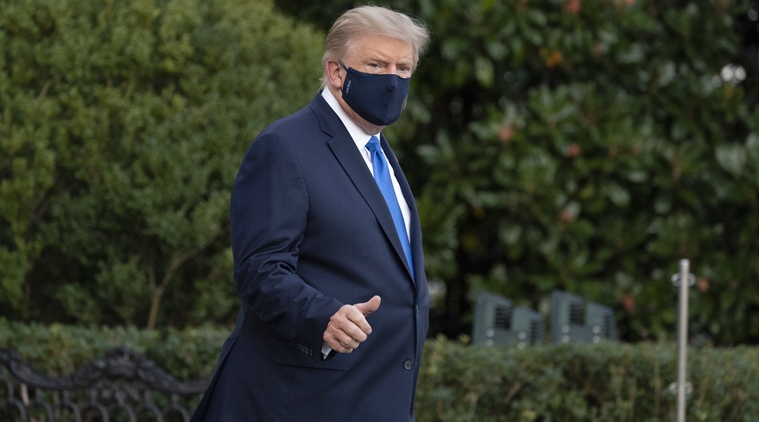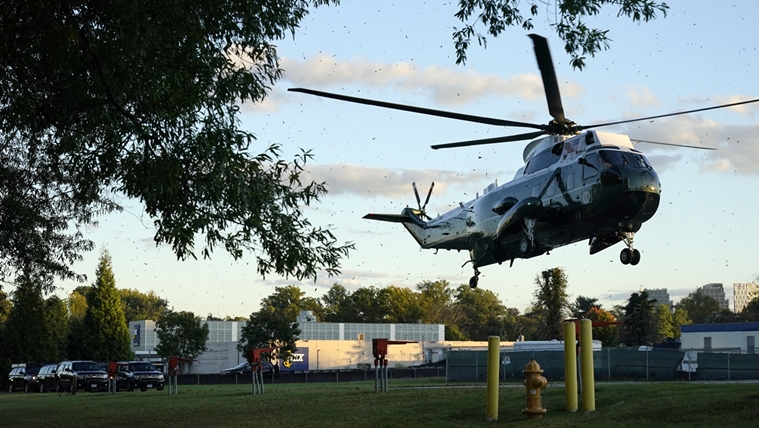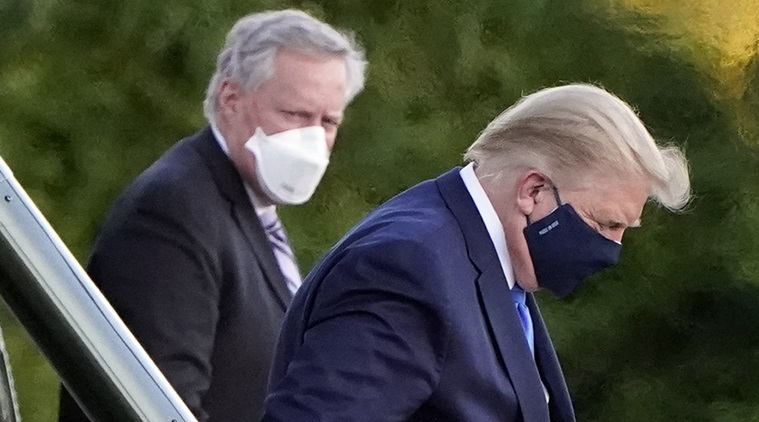- India
- International
President Donald Trump hospitalised with coronavirus, cancels campaign events
Roughly 17 hours after he announced that he had tested positive for the coronavirus, Trump walked slowly from the White House to a waiting helicopter to be taken to Walter Reed National Military Medical Center in Bethesda, Maryland.
 President Donald Trump arrives at Walter Reed National Military Medical Center, in Bethesda, Md., Friday, Oct. 2, 2020, on Marine One helicopter after he tested positive for Covid-19. (AP)
President Donald Trump arrives at Walter Reed National Military Medical Center, in Bethesda, Md., Friday, Oct. 2, 2020, on Marine One helicopter after he tested positive for Covid-19. (AP)
(Written by Peter Baker and Maggie Haberman)
President Donald Trump was hospitalized Friday after learning he had the coronavirus and experiencing what aides called coughing, congestion and fever, throwing the nation’s leadership into uncertainty and destabilizing an already volatile campaign only 32 days before the election.
Trump was flown to Walter Reed National Military Medical Center after being given an experimental antibody treatment as the White House rushed to cope with a commander in chief infected by a virus that has killed more than 208,000 people in the United States. Officials said he would remain in the hospital for several days and canceled his upcoming campaign events.
— Donald J. Trump (@realDonaldTrump) October 2, 2020
The White House shrouded Trump’s condition in secrecy, saying little more than that he had “mild symptoms,” and officials characterized the hospital stay as a precautionary measure. But the normally voluble president remained almost entirely out of public view, skipped a telephone call with governors at the last minute and uncharacteristically stayed off Twitter nearly all day while people close to the situation said his fever and other symptoms worsened as the hours wore on.
“I want to thank everybody for the tremendous support,” Trump, wearing a suit and tie but appearing unusually pale and lethargic, said in an 18-second video taped just before getting on the Marine One helicopter and then posted on Twitter in his first public comment of the day. “I’m going to Walter Reed hospital. I think I’m doing very well, but we’re going to make sure that things work out.”
 President Donald Trump gives thumbs up as he leaves the White House to go to Walter Reed National Military Medical Center after he tested positive for COVID-19, Friday, Oct. 2, 2020, in Washington. (AP)
President Donald Trump gives thumbs up as he leaves the White House to go to Walter Reed National Military Medical Center after he tested positive for COVID-19, Friday, Oct. 2, 2020, in Washington. (AP)
Trump donned a black face mask and emerged from the White House shortly after 6 p.m., giving a perfunctory thumbs-up to reporters without stopping to speak as he walked unassisted to the helicopter. He was accompanied by Mark Meadows, the White House chief of staff, who was also wearing a mask.

The hospital trip was an abrupt change in plans after Vice President Mike Pence had told governors earlier in the day that the president would remain at the White House. Dr. Sean Conley, the White House physician, said in a statement that the president received a single 8-gram dose of a polyclonal antibody treatment while also taking zinc, vitamin D, melatonin, aspirin and famotidine, a heartburn medicine.
The president’s illness touched off a cascade of concern, suspicion, calculation and recrimination in response to a president hospitalized with a potentially life-threatening health condition for the first time in nearly 40 years. The White House was left in a state of shock while the capital pondered what-if scenarios in case the situation worsens.
Also Read | World reacts to Trump’s diagnosis with shock, unease and some glee
The sudden development could have unforeseen consequences. It could on the one hand complicate Trump’s drive to confirm a new Supreme Court justice before the election Nov. 3 while giving new impetus to long-stalled talks for another round of coronavirus relief spending, according to officials.
The first lady, Melania Trump, and the president’s close adviser Hope Hicks were also infected, as was Ronna McDaniel, the Republican National Committee chair, who was last with Trump a week ago on Sept. 25. But the rest of Trump’s family tested negative, as did Pence, Meadows, Secretary of State Mike Pompeo, Treasury Secretary Steven Mnuchin and other senior officials who are regularly in proximity to the president.
Former Vice President Joe Biden, the president’s Democratic challenger who was on a debate stage with Trump on Tuesday, was tested twice Friday, with negative results both times. Biden said he sent his prayers for a speedy recovery while also implicitly faulting the president for a casual and even reckless approach to the virus.
Also Read | Democratic nominee Joe Biden and his wife test negative for coronavirus
“This is not a matter of politics,” Biden told a labor union gathering in Grand Rapids, Michigan, while wearing a mask. “It is a bracing reminder for all of us that we must take this virus seriously. It is not going away. We must all do our part to be responsible. That means following the science, listening to experts.”
 President Donald Trump arrives at Walter Reed National Military Medical Center, in Bethesda, Md., Friday, Oct. 2, 2020, on Marine One helicopter after he tested positive for COVID-19. (AP)
President Donald Trump arrives at Walter Reed National Military Medical Center, in Bethesda, Md., Friday, Oct. 2, 2020, on Marine One helicopter after he tested positive for COVID-19. (AP)
Trump by his own admission has played down the severity of the virus, repeatedly declaring that it would vanish on its own; pressuring schools, businesses and sports leagues to reopen; disputing the warnings of his own public health experts; and questioning the effectiveness of face masks. He defied health guidelines by hosting campaign rallies and other events crowded with supporters who mostly did not wear masks or maintain social distance. Only hours before his own positive test, Trump insisted in a speech that “the end of the pandemic is in sight.”
No one could say for sure when the president was infected, but attention quickly focused on his ceremony in the Rose Garden of the White House last Saturday announcing his nomination of Judge Amy Coney Barrett for the Supreme Court. Several guests and reporters who were present or traveled with the president on Air Force One later that evening tested positive, including Sen. Mike Lee, R-Utah; Sen. Thom Tillis, R-N.C.; the Rev. John I. Jenkins, president of University of Notre Dame; and Michael Shear, a White House correspondent for The New York Times. Barrett had previously recovered from the coronavirus.
Trump is the latest world leader to become infected. Prime Minister Boris Johnson of Britain was so sick that he had to be hospitalized before later recovering. Prince Charles likewise contracted the virus, as have the leaders of Brazil, Honduras, Guatemala and Bolivia. But Trump has repeatedly brushed off concerns about his health, telling advisers that the coronavirus is a roll of the dice.
Also Read | On Monday, Trump updated the Nation on virus strategy. By Friday, he tested positive
While the virus is much deadlier than the ordinary flu, the vast majority of people infected by it recover, especially if there is no underlying condition, but the threat climbs with age. At 74, Trump is in the most vulnerable category, with the risk increased because of his weight, which is categorized as obese. Eight out of every 10 deaths attributed to the virus in the United States have been among those 65 and older.
Dr. David Nace, a geriatrics expert and director of medical affairs at the University of Pittsburgh Medical Center’s network of 35 nursing facilities, said in an interview Friday that people who do not wear masks are exposed to higher concentrations of the virus, which can worsen the course of the disease.
About 5% to 15% of men in their mid-70s die from the virus, Nace said, although Trump will obviously benefit from excellent medical care and from the increased knowledge about how to treat patients. “My big fear is that he probably had a greater exposure,” Nace said. “Right now, he’s doing fine, but we’re early in this, and if that’s the case, we really have to watch him in the next two weeks.”
Even assuming Trump recovers quickly, it could be weeks before he is able to return to a full public life, calling into question the future of his already-faltering campaign for a second term. Trailing Biden by a significant margin in most polls, the president had been trying to change the subject from the pandemic, a goal that may now prove even more elusive.
From Explained | Implications of Donald Trump testing Covid-19 positive — for the presidency, and for the election race?
The Trump campaign canceled the president’s plans to attend rallies in Florida on Friday, Wisconsin on Saturday and Arizona on Monday and likewise scrapped in-person events featuring Trump’s family. Pence, however, will return to the campaign trail to pick up the burden of making the administration’s case to voters as many have begun casting ballots.
Biden followed through on his campaign schedule for the day and plans to continue to, but Democratic officials said they were moving to take down television ads assailing the president for his handling of the pandemic, and the former vice president’s campaign manager emailed the staff warning against social media posts on Trump’s condition.
White House officials said Trump was well enough to continue working. “The president is in charge,” said Judd Deere, a White House spokesperson.
 President Donald Trump arrives at Walter Reed National Military Medical Center, in Bethesda, Md., Friday, Oct. 2, 2020, on Marine One after he tested positive for COVID-19. (AP)
President Donald Trump arrives at Walter Reed National Military Medical Center, in Bethesda, Md., Friday, Oct. 2, 2020, on Marine One after he tested positive for COVID-19. (AP)
But if the illness were to become worse, the president could temporarily transfer his powers to Pence under the 25th Amendment with the transmission of letters to the speaker of the House and president pro tempore of the Senate and then reclaim them once he recovers.
Since the amendment was ratified in 1967, presidents have done so only three times. In 1985, President Ronald Reagan underwent a colonoscopy and briefly turned over power to Vice President George Bush, although he did not explicitly cite the amendment in doing so. President George W. Bush did invoke the amendment twice in temporarily turning over power to Vice President Dick Cheney during colonoscopies in 2002 and 2007.
At the White House, staff members were in various stages of shock and disbelief Friday, unsure how to respond to a situation that may have been predictable but that many of them had never taken seriously. Some aides stayed home Friday, and others who for months have generally gone without masks in the West Wing in deference to a president who scorned them almost universally covered their faces.
Also Read | From disinfectant to denial: Donald Trump’s top claims about Covid-19 pandemic
There was rising frustration on the part of some aides late in the day that so little information was being released about the president’s health, in part because they worried it would stoke fears beyond the known facts. Some staff members described a rush for tests for themselves, with some told they could not get them.
Conley, the president’s physician, did not explain why Trump was taken to the hospital. In a statement released beforehand, he said that “the president remains fatigued but in good spirits.” He had a more positive assessment of the first lady, saying that she “remains well, with only a mild cough and headache.” The president, in his short video, said, “The first lady is doing very well.”
White House officials did not explain why Trump went ahead with a fundraising trip to New Jersey on Thursday even after learning that Hicks had tested positive for the virus. Meadows told reporters that the president’s entourage learned about her test result even as Marine One was lifting off from the White House to begin the trip to his golf club in Bedminster, New Jersey, and decided to leave some aides behind, but did not say why the trip was not canceled.
The experimental antibody treatment developed by Regeneron and administered to the president is one of the most promising candidates for a treatment. Initial test results indicate it can reduce the virus in the body and possibly shorten hospital stays. Although it has not been authorized by the Food and Drug Administration, the president’s medical staff reached out to Regeneron for permission to use it, and the FDA cleared it.
There is a long history of presidents falling seriously ill while in office, including some afflicted during epidemics. George Washington was feared close to death amid an influenza epidemic during his second year, while Woodrow Wilson became sick during Paris peace talks after World War I with what some specialists and historians believe was the influenza that ravaged the world from 1918 through 1920.
Four presidents have died in office of natural causes: William Henry Harrison, Zachary Taylor, Warren G. Harding and Franklin D. Roosevelt, while Wilson endured a debilitating stroke, and Dwight D. Eisenhower had a heart attack in his first term and a stroke in his second. Four others were assassinated in office: Abraham Lincoln, James A. Garfield, William McKinley and John F. Kennedy.
But such health crises in the White House have been rarer in recent times. Since Reagan was shot in 1981, no president has been known to confront a life-threatening condition while in office.
Apr 18: Latest News
- 01
- 02
- 03
- 04
- 05






































